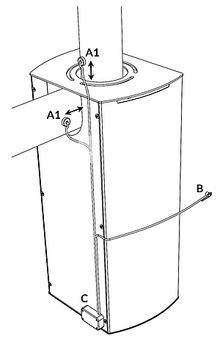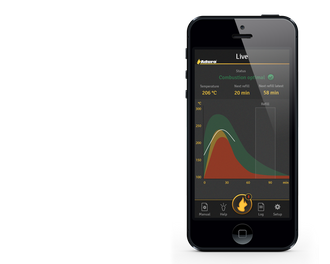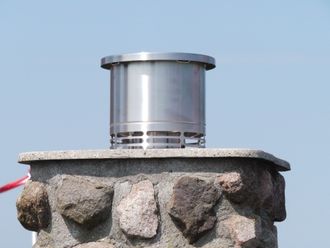The danskutviklede forbrenningsappen is not only aimed at Aduros own hearths.
Also competitors peisovner can take advantage of the new sensor-based system which can optimize the combustion.
We will ensure that the users get so many kWh out of the wood as possible, at the same time that they pollute the least, ” says the commander of the Aduro, Christian Skovbo, on the phone from Denmark.
Sensorbasert
Smart Response system is based on a termosensor and a sensor that tells when the door on the oven has been up. It indicates that it is posted more by in the combustion chamber.
the Point is to tell users when the combustion happens within the correct temperature range, but in older peisovner they must even make sure the right moves. The idea is that the feedback from the fireplace will make people to fyringseksperter.
 Sensors: For providing the app information about the fyringsforløpet attaches a termosensor to the flue and a sensor to ovnsdøra that tells you when it is open. The information is sent to your phone via Bluetooth.
Sensors: For providing the app information about the fyringsforløpet attaches a termosensor to the flue and a sensor to ovnsdøra that tells you when it is open. The information is sent to your phone via Bluetooth.
– It is not easy for ordinary people to know what is the correct temperature. With Smart Response, they can see temperaturkurvene graphically in the app, and then it is easy to fire properly by adjusting the operating conditions to peisovnen, i.e. the traction, ” says Skovbo.
What is the correct firing varies from model to model, but together with the Technological Institute in Copenhagen, the company has developed algorithms adapted to very many.
Naturally, it works algorithms the best of our own models, but by adjusting them to the drawings and data for the old and new peisovner, we can customize them so that they are at least 90 per cent of the idealtilstanden, he explains.
Aduros latest ovens are equipped with a system to regulate primærluften automatically so that the user does not need to do it yourself.
Smart Response costs around 900 dollars, but then the user must make sure to assemble the system themselves. The sensors are connected by cable to a small box which communicates with the smartmobilen via Bluetooth and provides users with a picture of forbrenningsforløpet and temperature.
Best of new
 Talking with the fireplace: the App provides users with information about forbrenningsforløpet and making sure they can adjust the traction so that vedforbruk and pollution is at least possible.
Talking with the fireplace: the App provides users with information about forbrenningsforløpet and making sure they can adjust the traction so that vedforbruk and pollution is at least possible.
It has gone well to develop the algorithms for the heaters back to 1995. It was then that the requirement for type approval of peisovner and that makes that there are good data on the various models from this period.
the Problem is the heaters that are older than this. Such peisovner has not sekundærforbrenning, and there is little in terms of data.
This is a type of fireplaces, the authorities like to see that we are replacing. They pollute much more than the modern.
the Advantage with the old ovens is that it is easier to get the guy on the wood in them.
– These old peisovnene have much poorer efficiency than the new clean-burning. All the way down in the 40 percent to 50 percent. They often have fumes at around 450 degrees and then pulls it well in pipa, ” Skovbo.
Struggling with bad move
Modern ovens with good efficiency around 80 per cent deliver much more heat in the house, instead of in the chimney, but then is røykgassene colder, typically 200 to 250 degrees. It provides a much slower pull.
It is also more resistance in such a furnace because gassvekslingen is more complex, and it also reduces traction. Trekkforholdene be affected to a large extent by the design of the pipeløpet, but we experience that every tenth customer has trekkproblemer. It is also stressed by the data that is collected by feiere from all over Europe. They tell that between 10 and 15 per cent of the pipes are bad for the modern peisovner, says Skovbo.
bad move means that it is difficult to get started with the metabolism, but also that there comes smoke out of the room, and the smoke that comes out the low speed so that the polluter locally.
Is the move, too bad it can be bad news for the neighbors. Bad move also means that the partikkelutslippet increases.
Three-in-one: This robot removes the snow, cuts the grass and rakes the leaves
Help to the poor piper
 A modern clean burning stove has a lower avgasstemeratur and it can give bad moves. A suction on top of the whipped may be the solution.
A modern clean burning stove has a lower avgasstemeratur and it can give bad moves. A suction on top of the whipped may be the solution.
to help those who are struggling with the move, has Aduro developed Draft Optimizer. It is simply a fan that is mounted on the top of the chimney and make for good pull either the oven or not.
Waved comes with eight feet of cable that is pulled down along the chimney and under the taksteinen to a place that is suitable for implementation. The cable ends in a 24 volt power supply and an interface that talks with a remote control on the radio over 433 MHz.
the Range of the remote control is between 30 and 40 metres, slightly less if it is in a brick house, ” says Skovbo.
Aduro is working with to develop the app so that the Draft Optimizer also will be able to be controlled through it.
They also work to connect the information from the various peisovnene to the a’s so that they can use all the information and optimize the algorithms. It will do that the users will get increasingly better control of combustion and reduced both vedforbruk and pollution.
Unsure about the utility
Not everyone thinks smart ovens will have any particular benefit. Executive vice president for sales in Wood, René Christensen, explains that they do not want to put sensors on their peisovner.
We are currently unsure of the effect of this. It is not so difficult to adjust the metabolism to the optimum area, but in some cases it may be a bad move. When not helping the sensors, ” he says.
Christensen points out that it in Norway is mandatory with so-called cleanburn technology, which is a sekundærforbrenning, and it demands more traction in pipa.
Is not it good enough it may be sensible to invest in an exhaust fan. There are several manufacturers of such fans, and they provide good moves even if pipa is not optimal, ” says executive vice president for sales in Wood, René Christensen.
No comments:
Post a Comment